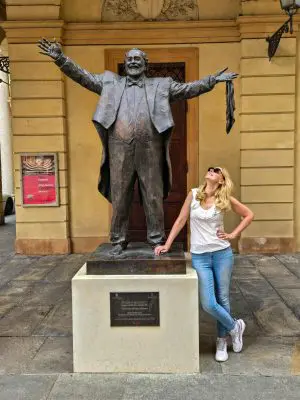
When you think of idyllic Italian destinations, Modena isn’t exactly at the forefront of your mind. But as we planned our trip to Northern Italy for three weeks, it was one of the cities we were eager to visit. For many it’s a little too far from top destinations such as Venice, Verona or Lake Garda. So why would we consider making the drive down there?
Although Modena has a lot to offer culturally, it’s known for being the birthplace and home of the Opera Singer Luciano Pavarotti. Having been fans of the famous tenor for a number of years, we were excited to visit the place he called home; quite literally. There is more to Modena than Pavarotti, with incredible sites and museums including the Ferrari Museum. In fact, be prepared to see Ferraris and Lamborghini’s everywhere, because the main factories can be found nearby.
So let us give you everything you will ever need to know about Modena and whether you should visit this enchanting city.
Ad Disclaimer!
This website uses paid adverts and affiliate links, these come at no additional cost to you and help us to fund the operation of the website, meaning we can continue to provide you with valuable content.
The money received from these links and adverts do not influence any recommondations made within our content.
Page Contents
Where is Modena and Why Visit?
Modena can be found in the Emilia-Romagna region of northern Italy, and it is about a two-hour drive from both Milan and Venice. It is famous for being the hub of Italy’s car industries, with many sports car makers being located there, whether its Ferrari, Pagani, Lamborghini or Maserati.
Within the centre of the city is the Cathedral of Modena, the Torre della Ghirlandina and Piazza Grande, which are all UNESCO World Heritage Sites since 1997. Interestingly Modena is also known for its production of balsamic vinegar, making it famous in culinary circles.
Although there isn’t the long list of attractions and things to see in Modena, unlike other Italian cities such as Rome and Milan. There are still some interesting cultural sites, with the added bonus of not having to manoeuvre around lots of tourists. Modena feels more authentically Italian especially within its historic centre, and this means that you can enjoy it at a much slower pace.
How Long Do I Need in Modena?
This is always a difficult decision, and in all honesty, we really struggled with Modena. In the end we had given more days than necessary, but it left us with some time to relax, which we were grateful for after a busy three weeks travelling.
How long you will need depends on what you plan on doing when you are there, because if it’s simply to see the city centre then one day will do. If you want to visit the museums and Pavarotti’s home, then you may need a little longer. We feel two days is enough, but if you want to really explore than give yourself three days.
Remember that many of the activities we will mention, aren’t within the city centre of Modena and will require transport. Thankfully we had a car to drive around, but we can imagine it is hard if you don’t.
Where to Stay in Modena?
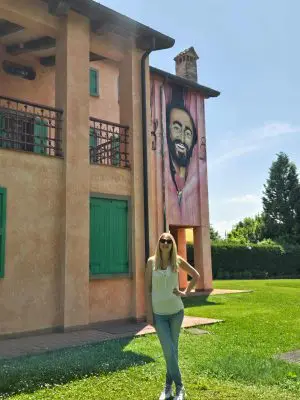
As you can imagine this will depend on your transportation around the area, for example if you have a car then you can stay somewhere further out like we did. We booked an apartment in Limidi which is about 25 minutes from the centre of Modena and for the four nights we stayed there it cost less than three hundred pounds.
If you are staying for a day in Modena or you don’t have access to a car, then you will probably want to look at accommodation in the downtown part of the city near the Piazza Grande. Modena’s train station is called Piazza Dante Alighieri and it’s a 15-minute walk from the Piazza Grande. This makes it a great option if you’re choosing public transport to get around Italy. Although we haven’t personally used the train system in Italy, we have been told it’s inexpensive and easy to use.
We’re not going to recommend specific hotels or accommodation, because as we mentioned above, we stayed outside the city. If we could throw in a suggestion to those of you who have hired a car for your trip and that is to find somewhere cute and Italian in a village or small town. We loved our little apartment near Modena and have found lots of others throughout our trips to Italy. In particular a mountainside apartment near Amalfi which was as local as you could find, but it really added to our experience.
Related Guide – Our Guide to Travelling Around the Amalfi Coast and Campania Region – The Best Things to do, Places to See and Top Tips
When to Visit Modena?
Our trip to Modena was in May 2025, where we spent three weeks driving around the north of the country to various cities such as Milan, Verona and Venice. During that time the weather was very hit and miss, with plenty of rainy days. But we have gotten use to the weather in Europe being unpredictable.
Of course, there are certain seasons where you will have the chance of better weather, whilst dodging the throng of tourists. Either way it is always best to prepare, so our first bit of advice is to check those weather apps for the period of time you’re going away. They’re not always perfect, but they will help you gauge both the weather and temperature whilst you’re there.
Having an idea about seasonal changes can give you a great place to start, because you’re probably booking this trip a few months in advance. For most people it’s difficult to travel outside of school holidays, but if you can, then we tend to recommend Spring and Autumn months as the better times to visit. April and May, or September and October are the sweet spots, mainly because the summer can get incredibly hot and make it uncomfortable to walk around.
It’s not just the heat which can make the summer months unbearable, because they also tend to be the peak time for tourists. This can make it harder to get into those popular attractions, which is difficult if you’re trying to cram a lot into a short space of time. Modena isn’t as popular for foreign tourists as other cities, but you’ll still find more of an influx during the warmer months, especially for the museums.
In contrast, you will find the queuing times shorter in the winter months, but the attractions may close earlier. This is why we recommend Spring or Autumn, because we had light until 8 or 9pm and attractions were open a little later.
Something else to consider are the public holidays in the Emilia-Romagna region, because they can impact what is open. Aside from the usual Christmas, New Years and Easter, there is pretty much one public holiday in each month, making it hard to work around. Our advice is just to be aware of it, because if you’re in the city for one day then it being a bank holiday can be a problem.
Hopefully by taking all this into consideration you’ll be lucky enough to find a sweet spot, where it’s not too busy and the weather is perfect. If the weather isn’t on your side, then fear not because there are plenty of things to do on our attractions list which are inside.
What to Pack for Modena?
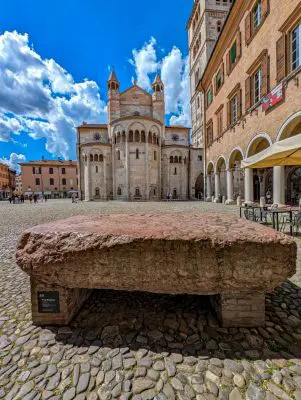
We find this difficult to answer because as we have mentioned previously, the weather can be unpredictable in Europe. Our advice to any travellers is to pack layers, especially if you’re in warmer seasons because you can remove if you’re too hot or wrap up if you need to. Obviously in the winter you’ll want to prepare for the cold, especially because some of the main attractions are outside. The best thing to do is before you begin to pack, take a look on Google at the weather and temperature so you can gauge what to wear.
Clothing can range from the usual t-shirts and jackets, to something a little more formal for the evening if you’re heading out for a meal. As you can imagine comfortable shoes are essential, because the best way to get around the city is by walking. Thankfully in comparison to other Italian cities Modena is quite flat, but you’ll still get a lot of steps in and end the day with tired feet.
Aside from clothes you will need the usual toiletries, medication and plug adaptors. We have read that medications can be different in Italy, and some are difficult to get, so make sure you have enough. There are plenty of shops around where you can buy any bits you may have forgotten.
Getting Around Modena – Transport Options
One of our favourite things about Modena, is that the historic downtown centre of the city is quite compact and easy to walk around. As well as walking there are other options to move around the city and area, including buses, cycle paths, taxis and Ubers. In fact, Modena has an extensive network of cycle paths, so it is easy to make your way around the city. Although you won’t need to use a car to get around the city, you may have travelled in by one. There are plenty of car parks in the city, but we chose the Parcheggio del Centro which was only a short walk from the duomo and piazza.
Walking
This is the easiest and cheapest option, and one we would recommend because Modena is incredibly easy to wander around. The problem with public transport is that although you can rest your weary feet for a bit, you miss out on the beautiful streets and sights of the city. Everything you will want to see that’s on our list is quite close to each other, so the fact it’s compact is ideal for walking.
Buses and Trams
Within Modena and the surrounding area, you will find a comprehensive bus network which is operated by SETA. The buses run frequently with routes connecting the historic downtown, to the surrounding towns such as Carpi, Correggio and Maranello. Although the distance to the train station from the centre is only a short walk, there is a bus that runs between them every 10 to 15 minutes.
To purchase tickets on the bus, look for a green ticket machine and pay using a contactless card. Sadly, you cannot buy more than one ticket at the same time with the same bank card. If or when you change buses, you will have to validate your bank card again. The ticket price will not be charged again if you are within the valid time or geographical zone of the selected ticket.
If you are subject to an onboard inspection, then you only need to give the staff member the last four digits of your card. They do not require your actual card, so make sure you keep it safe.
In general, a single urban ride in Modena tends to be less than a couple of Euros, but you can also purchase a daily pass (this is automatically applied after 3 purchases in the same day).
Bicycles
Alike much of Itay, Modena is very bike friendly and offers around 190 bike routes and cycle paths. There are bike share and rental services available in the centre of the city and the cost is quite reasonable. Personally, we wouldn’t bother hiring a bike and simply walk instead, but if you’re thinking of cycling to any of the museums etc, then we’d suggest alternatives because they are quite a distance.
Taxis and Uber
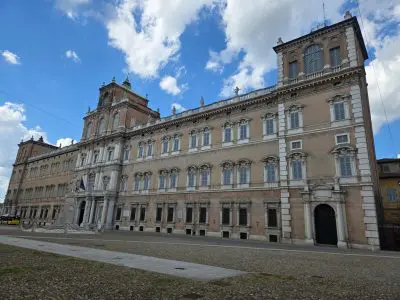
Both Taxi and ride share services are available in Modena, more specifically Uber. We don’t really recommend this option of transport, mainly because it costs a lot if you use it regularly. But we understand that it’s not as simple for everyone and many of you aren’t able to drive yourselves when you’re there.
The taxi companies in Modena have special taxi fares for tourists departing from the city centre to the major tourist locations, such as Museo Ferrari di Maranello, Museo Lamborghini and Museo Ducati. As you can imagine this is quite expensive each way, but if you’re in a group then it would make it a little cheaper.
Trains
We mention trains as an option purely for those who may need them to travel to and from Modena. You wouldn’t really need them once you’re in the city, but they offer direct train services to many other Italian cities.
Modena Tourist City Tax – Does It Have One?
Most travellers know that visiting major cities and vacation spots come with hidden costs. Tourist city taxes appear to be growing in popularity and although you may think it is for tourist hotspots only, we’re seeing an increasing number of smaller cities apply it.
It’s common place in many European cities to add a few Euros per guest, for each night you stay in a hotel or similar accommodation. During our visit we were not asked to pay anything extra to our accommodation cost. But that may be because we stayed a little further out of the city, or it was added to the original price.
From our research the city tax is per night and depends on the star rating of the hotel you are staying in. 3 stars is 2 Euros, 4 stars is 3 Euros, and 5 stars is 4 Euros per night. It’s not as steep as some cities in Italy, but for many it’s a shock to see that pretty much every potential tourist spot already has some kind of tax added to your stay.
Our List of Attractions and Things to do in Modena Italy
For most of you looking at guides on Modena, the ‘Things to Do’ section is probably the main thing you’re looking for. Within the city itself there isn’t loads, but you’ll find enough to keep you entertained. If you have the ability to travel to the museums outside of the centre, then we’d highly recommend it. There are some great museums within the region, but we’ll provide you with more detail below.
Although we didn’t manage everything on our list or chose not to head to certain museums. We have still added the main ones to this guide so you can choose what you do or don’t want to see.
We’ll begin by bringing you the favourites from our trip and then the popular options. You’ll be surprised by how many of these are completely free, which will hopefully leave you a few pennies to try out some incredible Italian food. But we’d also recommend that you take some time to simply wander around the historic centre of Modena and enjoy that local vibe, which you don’t really get from the bigger cities such as Milan and Rome.
Related Guide – Rome Travel Tips
Casa Museo Luciano Pavarotti
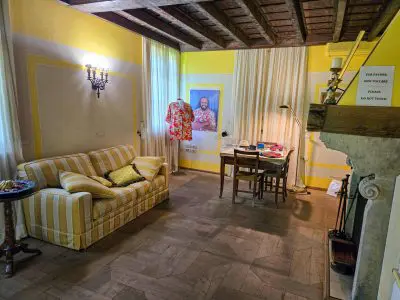
Although the Casa Museo Luciano Pavarotti is outside of the city centre, we mention it first because it was the reason we visited Modena and our favourite thing to do there. Driving to the museum takes 15 minutes from the centre, but you can also take the 731 bus from Largo Garibaldi to Cantone di Mugnano, which takes about an hour and a half for a few Euros each. Taxis are a little more expensive as you would imagine and you’ll be looking at around 20 Euros each way.
For those of you who do not know who Luciano Pavarotti is, or why we would tailor our trip for one museum. He was an Italian operatic tenor; in fact, he was considered one of the best tenors of all time. His career not only made him popular within the realm of opera, but it also crossed over into mainstream music and helped with the popularity of the genre.
Pavarotti was born in Modena, and the Casa Museo Luciano Pavarotti is the home that he built there and where he lived his remaining years. It’s a glimpse into the life and career of the exceptionally talented man who not only worked there, but he would teach young singers for free, as well as welcome friends and family.
What we loved the most is that this beautiful home is exactly as Pavarotti left it, with many of his belongings such as clothing and furniture still there. There are 12 rooms on 4 floors each covering a section of his life and career.
Before we go into the various rooms you will see during your visit, let’s start with arriving at the Casa Museo. Parking is free and can be found in an unguarded field across from the house, so make sure you have any valuables with you. As you cross the road you will see an entrance sign on a gate which leads you to the house. The house is to the right, but first you need to head left into the ticket office and shop. They sell a few bits such as t-shirts, CDs, mugs and books, but we’d recommend you save that until the end.
The Casa Museo Luciano Pavarotti is open daily from 10am to 6pm, with the last entrance being 5pm. The cost to enter is currently 12 Euros (May 2025), which is incredibly reasonable for a place so special. Once you have bought your ticket, you will be given an audio guide which is available in Italian, English, Spanish, French, German, Portuguese, Chinese, Russian. Within each room there is a number, and you simply enter it into the audio guide and listen to the wealth of interesting information.
For those of you with mobility issues, you’ll be pleased to know that although the house has 4 floors, there is a lift which allows access to all areas.
When we arrived, there was a press conference being held, so we had to navigate the house a little differently than expected. But we’ll still go through the house as you normally would when you visit.
The entrance to the house is opposite to the ticket office and once you enter, then head left, and you will be in the piano room. This huge room holds lots of memorabilia and artifacts which Pavarotti loved. It also is where he spent most of his time with friends and playing cards. There is a Steinway piano in one section of the room, the tailcoat he wore to concerts and his iconic white handkerchief. On the walls are autographed letters from composers such as Puccini and Verdi, which are so interesting to see. There is even the curved nail which was a good luck talisman for Pavarotti.
Down the hall from the first room is the kitchen, which is bright and bold alike the maestro himself. You’ll find lots of knick-knacks which show Pavarotti’s fun side and interestingly there are two sinks, because he liked to be in the kitchen with others as he cooked.
To the right of the entrance is a room called ‘the joy of living,’ which reflects the sunny personality we knew and loved. The room has lots of personal items he collected, as well as clothes such as his bright floral shirts. But you’ll also see a collection of paintings done by Pavarotti in the 80s and 90s which are signed by his pseudonym LUPA (first two letters of fore and surname). What we loved about this room is that it gave us an insight into who this iconic man was, not only a famous singer but a beloved friend and creative soul.
You then head up to the next floor and as you turn right, you’re in a room which is flooded by light. Around the walls are the many awards Pavarotti received including Grammys and Emmys. There are photos around the room of him during award ceremonies and a video showing his many performances. After you finish there, you’ll head to the bedroom which is where Pavarotti passed away on the 06th September 2007. Being in the room was quite an unusual and intimate experience, imagining the loss of such a great man to the world of music. Around the room you will see pieces of Pavarotti’s life, and there’s even a walk-in closet which has his clothes and accessories such as his famous Panama hats and scarves. Next to the bedroom is his bathroom with monogrammed robes and towels. After that you walk through red velvet curtains into Pavarotti’s legacy in opera.
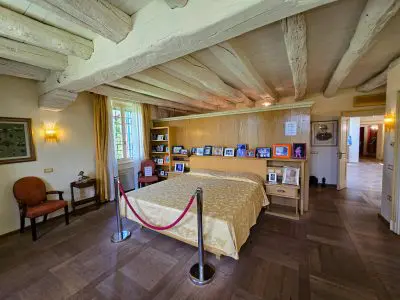
The rest of the rooms on the first floor are dedicated to Pavarotti’s career in opera, since his debut in 1961. The rooms have some of the costumes he wore in his favourite roles throughout his career.
After you walk up to the top floor you’ll see a beautiful bright open space with photographs of Pavarotti with celebrities; many of whom were his friends. At the back of the room are private letters from icons such as Lady Diana and Sinatra, but also memorabilia owned by Pavarotti. There is another room of unpublished works and then a final cinema type room which plays unpublished private footage of this great tenor. Once you have finished then you can take the elevator down to the basement or -1.
When you exit the elevator, you will enter the Decca Room named after the record company Pavarotti trusted. It shows the many different albums he recorded throughout his career, because he believed that everyone should have access to music. As you wander around the room you can listen to some of his most famous arias, which have been remastered to show the purity of the maestro’s voice.
The next room is a wonderful collection of tributes from Pavarotti’s many fans around the world, with messages and artwork. Finally, there is a video of the Pavarotti and Friends concert, which was amazing to watch, especially so many awesome bands and singers.
Once you’ve finished this room, then you will head back upstairs, and the tour is finished. Make sure you head outside to see the gardens and the beautiful mural of Pavarotti on the side of the house. Even if you’re not a huge fan of opera or Pavarotti, we’re sure you will enjoy a glimpse into the life of what can only be described as a legend in popular culture. He will forever be iconic in the music world, and we felt that the Casa Museo Luciano Pavarotti captured so many aspects of his amazing life, both professional and intimate. For such a great price how could you miss out?
Piazza Grande
The heartbeat of Modena is the Piazza Grande which means the Great Square in Italian and dates back to the 12th century (it was known as Piazza Grande from the 17th century). The UNESCO World Heritage Site since 1997 includes the square itself, the Modena Cathedral and Ghirlandina Bell Tower. As you walk into the large space of the square, you will be blown away by its Romanesque architecture. As with many piazzas, this was the heart of the cities religious, political and social life for centuries. But now it’s a great spot to sit and relax, in one of the many restaurants or cafes located around the square. As well as the many buildings, this is where you’ll see the Pietra Ringadora and the statue of La Bonissima which is the symbol of Modena.
We loved wandering around the square and visiting the cathedral and tower, it felt more authentic than other touristy Italian cities. It’s also the ideal location to begin from, because all the other things to see, span out from there.
Modena Cathedral – Duomo di Modena
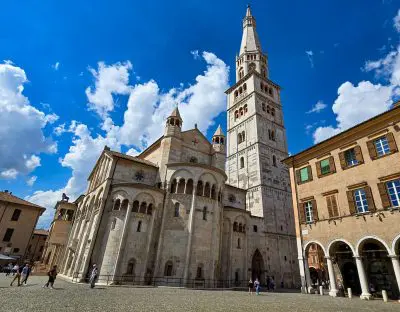
Smack bang in the centre of the Piazza Grande is the Duomo di Modena, which is a Roman catholic cathedral designed by the architect Lanfranco. It was consecrated in 1184 and along with its bell tower, the Torre della Ghirlandina, it was designated a World Heritage site in 1997. Interestingly the funeral of Pavarotti was held in the cathedral. Modena cathedrals façade has beautiful reliefs and sculptures, so take a moment to walk around the entirety of the building.
As you would expect, entrance to the church is free and it is open most days between 7am and 7pm (except Monday when the hours vary). If you want to access the upper presbytery which gives an elevated view of the nave, then there is a fee of 2 Euros. You can access the upper presbytery from Tuesday to Saturday 10am to 5pm and then Sunday 1pm to 5pm (it’s closed on Monday).
The interior, which was sculpted by Wiligelmo, is separated by three naves but it’s the décor which will leave you in awe. There is a marble parapet between the central nave and crypt which portrays the Passion of Christ and Last Supper. The pulpit is decorated with small terracotta statues and there is a crucifix from the 14th century.
There are two doors to the cathedral which date back to the beginning of the 12th century. The relief work on the Porta dei Principi or Princes Gate which looks onto the Piazza Grande, tells the story of Saint Geminianus who was the Patron saint of Modena. The other door closer to the tower is called Porta della Pescheria or Fish Market gate, where two sculpted Telamons represent the burden of man and his work.
We sadly didn’t go into the cathedral because we had read there was a 6 Euro entrance charge. Knowing now that it’s free, we wish we had gone inside or at least asked. Everything in Modena feels authentically Italian, so we would have loved to have seen what the cathedral offered in terms of architecture; especially having been to Doges Palace in Venice and Duomo di Milano.
Ghirlandina Bell Tower
The beautiful marble bell tower known as the Torre della Ghirlandina is a sight to behold and the symbol of Modena. It stands 86.12 metres above the Piazza Grande, next to Modena Cathedral. Initially the tower was known as Torre di San Geminiano in 1179 and was on five floors. It was built to compete with Bolognas towers and had added sections and renovations during the 13th and 15th centuries. This includes the top of the tower which has two ghirlande which means marble railings.
Not only is the tower an architectural masterpiece, but it also held an important function for the city throughout history. This includes alarming people if there was danger and announcing the opening of the gates in the city wall. Within the tower you found the ‘sacristy’ of the municipality which was home to public documents and artifacts of importance. Currently you’ll find a room of 15th century frescoes and some sculpted capitals in the Torresani room.
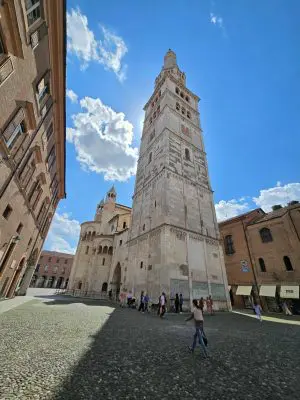
If you’re looking for something active, then why not climb to the top of the bell tower which is around 200 steps. As you can imagine after so many steps you can enjoy incredible views of Modena below. There is a cost to climbing the tower but it’s only 3 Euros and times vary depending on the season and day. Our advice would be to look online before you go, but in general it’s about 9.30am to 1pm and 2.30pm and 5.30pm.
For those of you who have physical difficulties or who don’t really fancy the climb, then you can enjoy Ghirlandina Bell Tower from the Piazza.
Ferrari Museum in Maranello
During our research we got a little confused when it came to the Ferrari Museum, because there appeared to be different names and locations for it. Turns out that’s because there are two museums focused on this exclusive sports car. The first is in Modena called the Enzo Ferrari Museum and the second is in Maranello called the Ferrari Museum. Enzo Ferrari Museum is the birthplace of the founder of Ferrari, whereas the second is close to the Ferrari factory, so be prepared to see lots of beautiful sports cars being driven around.
If you want to visit the two museums, then there is a pass available for both. There’s even a pass which includes the two Ferrari Museums and Pavarotti’s house, called the ‘Discover Ferrari and Pavarotti Land’ which is currently 48 Euros (May 2025). This pass also offers guided tours from participating businesses in Modena, including traditional balsamic tasting, and shopping discounts at select shops in the city. We didn’t buy the pass because we hadn’t completely decided what we were going to visit, but from looking at the cost it is worth it.
The Ferrari Museum was opened in 1990 with a specific focus on Scuderia, racing and special Ferraris such as super cars, which were the ultimate grand touring cars from that brand. We’ll begin by saying that we didn’t actually go into the museum for one specific reason, we couldn’t find anywhere to park. The parking space outside is small and there isn’t much in the surrounding streets where you can park safely. We’ve read of other visitors parking a distance away and walking in, but we didn’t. Our advice would be to get there as early as possible and pray there’s a space.
Once you’ve bought your ticket you will enter the Victories Room. This focuses on Formula 1 cars who have achieved success, but also the drivers and an impressive collection of trophies. Ferrari is renowned for its success in F1, and for producing a number of world champions.
You will find another room which focuses on Scuderia Ferrari, which in Italian means stable. This section of the museum is illustrated in wall panels which begins in 1947 with the first car built by the car brand, and its first victory (won during its second race).
One of the biggest complaints that people have about the Ferrari Museum, is the lack of cars. Those of you who have been to other car museums, know that you’d normally see a vast collection. There is a shop and café for those of you who need a refresh before you head on with your day. Aswell as the museum there are other activities you can enjoy, including a visit to the factory or the Fiorano track which is close by. If you are lucky then you’ll see Ferrari’s riding on the track and you can also book a driving experience, but we’ll prewarn you it’s pretty pricey.
Within the museum there is a simulator, but this is an additional cost, and we have read it’s not worth the money. As with many museums there is a photo opportunity where you can have your picture taken at the wheel of a Ferrari, but again this comes with an additional cost.
Whether or not you go into the museum, the Ferrari factory is found in the centre of Maranello, making it a spectacular place to wander around. You will see the iconic factory doors which are ideal for a picture or two, you may also spot the employees in their work gear wandering around. Close by there is a Ferrari hotel and store which sells a myriad of items with the brands design.
The Ferrari Museum is open between April to September from 9.30am to 7pm, and October to March from 10am to 6pm. The cost will vary depending on the time of year, so from September to May it’s 27 Euros and during June, July and August it’s 32 Euros (May 2025).
Enzo Ferrari Museum
Enzo Ferrari was an Italian racing driver and entrepreneur who founded the Ferrari company, which as we know is one of the most famous car companies in the world. The Museo Casa Enzo Ferrari or Enzo Ferrari’s Birthplace Museum opened in 2012 and includes a restored house of where he was born. There’s also a beautifully designed exhibit center which houses a large exhibition of vintage cars. This museum is located in Modena where Enzo Ferrari was born, and yes, we also noted the significance that both the greatest tenor and one of the best sports car entrepreneurs, both came from the same place.
The replica of Ferrari’s home gives you an idea of where he lived, including his laboratory-garage. You will learn about his life through short films and information boards (which are in both English and Italian) which tell you about the man, driver and car maker. Within his office there are many personal items and memorabilia. The second building provides a history of Modenese sports motor racing, with cars displayed like works of art, including the 1947 ‘Colombo’ V12. If you want to visit the Enzo Ferrari Museum, it’s open from October to March between 10am and 6pm, or April to September from 9.30am to 7pm and costs 27 Euros (May 2025).
Teatro Comunale Luciano Pavarotti and Monument
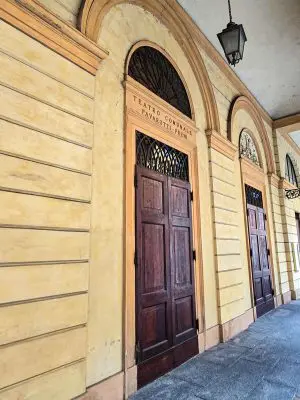
As we’ve already mentioned a few times, Modena is home to the master Luciano Pavarotti. So, it may not surprise you to know that the cities theatre is named Teatro Comunale Luciano Pavarotti – Freni (Mirella Freni was Pavarotti’s foster sister who died in 2020).
The theatre which opened in 1841 is a short walk from the duomo. It doesn’t stand out as being a notable building, but to be fair, neither did La Scala in Milan. You will know you’ve arrived because there is a statue of Pavarotti at the side, holding his famous handkerchief. We had read that there is a tour of the theatre, but we couldn’t find anything around the building to confirm that was true. Online a few blogs mentioned a one-hour tour for ten Euros, but we went back twice, and nothing was open to visitors. We suspect that the only way to see inside the theatre is if you have tickets to an opera or performance, but this can be difficult to book last minute.
Even if the theatre isn’t much to see from the outside, we would certainly recommend visiting the site simply to pose with the master himself.
Palazzo Ducale – Ducal Palace
After walking around the piazza, we headed over to the Ducal Palace which was home to the Este family between 1452 and 1859. The palace has a Baroque façade and although not as splendid as others we have seen, it’s still worth a visit. You can walk along the outside of the building and just inside the entrance, but there isn’t daily access to the palace because it is currently used as the home of the Italian Military Academy, the Military Museum and a library. This means you will see lots of young military personnel wandering around the streets of Modena.
Now we had read that there are tours available of the interior of the palace, but they are only on weekends for 10 Euros. The tours are in Italian, but if there were enough visitors they will include English options.
During the tour you will see a beautiful staircase which goes from the Honour Court to three of the apartments, these were decorated with frescoes and portraits of the Este family. There’s also a Hall of Honour and the 18th century Golden Salon.
Novi Ark Archeologico Park (Parco Novi Sad)
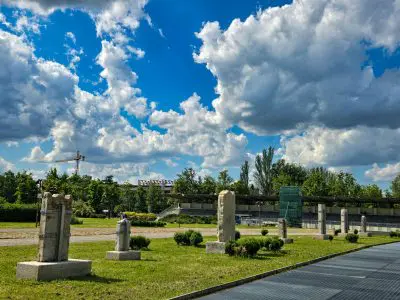
During our visits to Modena, we parked in an underground car park not far from the football stadium. As we came out of the car park terminal, we noticed we were in a park. It turns out this was the Novi Ark Archeologico Park which was on our list of things to do. We’ll start off by saying that the area seemed a touch dodgy and we’ve read other reviews saying the same. But if you have the time and you’re interested in seeing free Roman ruins, then why not head over and check it out.
The ruins were discovered during excavation of the car park, and we have read that they are from the ancient city of Mutina. Found in the excavation was a necropolis, tombs, rural buildings and a road, as well as other archaeological materials. The different sections of ruins are dotted along the open-air complex in chronological order from the 1st century to the 5th century AD. Interestingly the entire Roman road which covers 118 meters and is 5 meters wide, was remounted and as you walk along there are marks where the wagons moved in and out of the town. The best thing about attractions such as this is that they are open and easily accessible whenever you want. There are information boards near each ruin, explaining the history and what you are looking at.
Pietra Ringadora
As you walk into the Piazza Grande by the Duomo di Modena, you’ll notice in the corner a large red marble stone. The Pietra Ringadora or the Haranguing Stone in Modena dialect, has been used for various things over the centuries. Originally it is believed to have belonged to an ancient Roman amphitheatre, but it was then moved to its current position and during medieval times was a stage for the town crier to make announcements, orators and popular speakers. It also has a grisly history because it was the site of executions, and the bodies would then be displayed as a deterrent for criminals and so they could be identified. For something so gruesome, the stone is quite beautiful and it’s an interesting addition to your list of things to see whilst you are in Modena.
Mercato Albinelli
The Albinelli Market is an important spot in Modena and has been since the Middle Ages, so why not take a look. We got a little confused and thought we had been to the market by the Novi Ark Archeologico Park, but we now realise this wasn’t the same one. Mercato Albinelli is an indoor market close to the Piazza Grande, and it is open between Monday and Saturday from 7am to 3pm. As with many indoor markets in Europe, you can find restaurants there and they are open from 12pm to 3pm and then from 6.30pm to 11pm.
The market is considered one of the most beautiful in Italy because of its art Nouveau style. There is a fountain in the centre with a sculpture of a beautiful woman called the ‘fruit bearer’. As you’ll have seen from other European markets there are lots of counters, 65 to be exact, with meat, cheese, bread, fish, fruit and vegetable stalls; to name a few. Even if we’re not buying anything, we love walking around local markets, enjoying the atmosphere of the everyday traditions of Modenese culture.
Via Farini
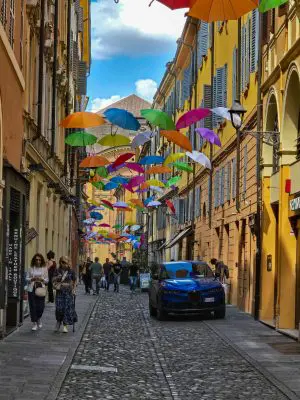
As we researched the sites of Modena, one of the ‘things to do’ was Via Farini which is a street near the Ducale Palace. Originally known as the Rua Grande, this street is ideal for strolling. Look out for Giusti which is the oldest food shop in Europe (opened in 1605), you can enjoy a coffee or Aperitivo. We had been told this street was the epitome of rustic Italian charm, but in all honesty, we only realised we had reached it once we had walked to the end. It didn’t really wow us, but you may feel differently when you’re there, and it’s on the way to the palace and theatre.
Church of Saint Augustine
We know that during your time in Italy you’ll probably have seen a lot of churches, but this one is an important building for the people of Modena. Founded in the 14th century by the Order of Augustinian Hermit, it was refurbished during the 16th century for the funeral of Duke Francesco and became the Este Pantheon where the family funerals are held. Within the church there are sculptures and paintings depicting monarchs, empresses, kings, queens and saints. You can visit the church every day for free, but the hours can change slightly depending on the day. Generally, they tend to be 6.40am to 12.30pm and then 4pm to 7.15pm, but obviously this may change if there are celebrations or services in the church.
Additional Attractions in Modena
Above is the list of popular attractions in Modena, but there are still others that we sadly didn’t make it to. To give you a comprehensive guide here are the attractions that you may wish to visit.
- Lamborghini Automobile Museum – Found 30 minutes from Modena centre, the museum explores the history of Lamborghini with beautiful models and a tour of the production line. It’s 18 Euros (May 2025) and open daily from 9.30am to 7pm.
- Madonne Caseificio dell’Emilia – This cheese factory shows different phases of Parmigiano Reggiano processing, from milk delivery to the finished product. There is a factory shop where you can taste a range of aged cheeses. The tour costs 20 Euros and lasts one hour, it’s open every day from 8.30am to 7.30pm, except Sunday which is 9am to 1pm.
- Acetaia Giusti – You can visit the Casa Giusti every day from 9am to 6pm for free, to see how they make Giusti Balsamic Vinegars. The tour lasts around an hour, and it includes the family museum, the ancient aging rooms and a tasting of their beautiful Balsamic Vinegars.
- Panini Motor Museum – This private museum of the Panini family offers a collection of around forty Maserati cars and vintage motorcycles including Ducati’s. The museum is free and open Monday to Friday, 9am to 12.30pm and 3pm to 6pm, then Saturdays from 9am to 12.30pm.
- Galleria Estense – This art gallery is in the centre of Modena and houses a collection from the d’Este family who ruled Modena, Reggio and Ferrara from 1289 to 1796. Entrance is 8 Euros, and it’s closed Mondays, open 8.30 to 7.30pm Tuesday to Saturday and open from 10am to 6pm Sunday.
- Museo della Figurine – A museum dedicated to collectable cards, closed Monday and Tuesday. Open Wednesday to Sunday between 3pm to 7pm and costs 6 Euros.
- Palazzo dei Musei – Museum of art, archaeology, history and civics in the 18th century Ducal Armory. Its open most days 8.30am to 7.30pm (except Sunday and Monday), and costs 8 Euros.
- Modena Civic Museum – An impressive collection of Modenese exhibits including artwork and sculptures. Entrance is free and hours vary, so our advice is to check online before you go.
Should I Visit Modena?

This will depend on a number of factors, the main one being how easy it is for you to get to Modena. Most tourists don’t specifically fly into the area to see Modena; it tends to be an addition to visiting places such as Milan and Bologna. You can get trains to the downtown area of the city, but driving there is much easier, especially if you are using the toll roads. Driving in Italy gives you the flexibility to see many more places than public transport ever could, so we highly recommend it.
If you are driving and within the area, then we would say yes to the question of whether you should visit. Although you won’t have endless activities like many other Italian destinations, there is still plenty to do and see. Much of it is in the region around Modena, such as Pavarotti’s House and the Ferrari Museum. We felt that the city only required half a day to walk around, because the main section was quite small. But you can always incorporate it with a nice meal or aperitifs, which is quintessentially the Italian thing to do.
As Pavarotti fans we loved to walk in the footsteps of a legend, so if you’re an admirer of the greatest tenor of all time then Modena is a must. It’s also a sports car enthusiasts dream location because they are honestly everywhere, we even saw a few Lamborghinis whizz past as we headed up the toll road back to Milan.
We can’t say that Modena was the greatest place we’ve been to in Italy, or even in the top five. It had some authentic qualities which we loved, but in all honesty if we were flying to Italy and only visiting Modena then we would probably have been a little disappointed. There’s a reason why travellers tend to include it as part of a bigger vacation.
Would we go back? Probably not, we feel like we have seen everything we wanted to. But that doesn’t mean we won’t be recommending it to family and friends. If you do end up visiting Modena, then make sure you tag us on Instagram, because we love to see what you’re up to as you tick off your bucket lists.